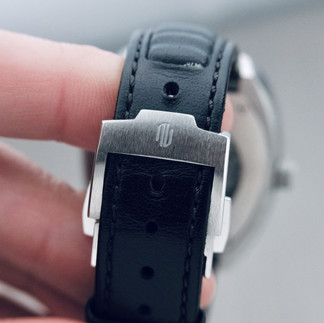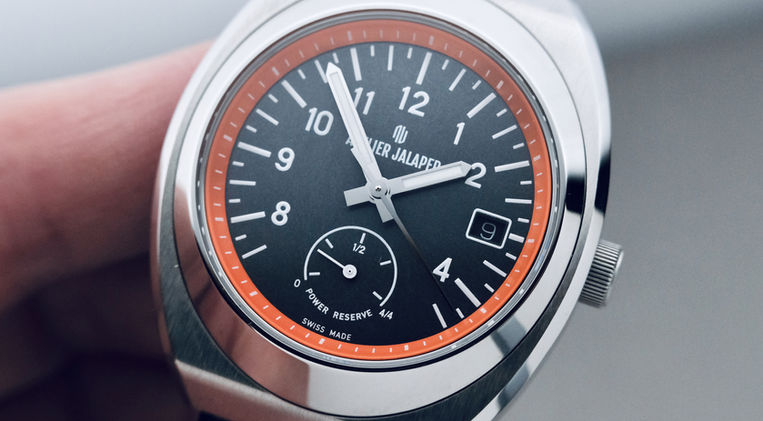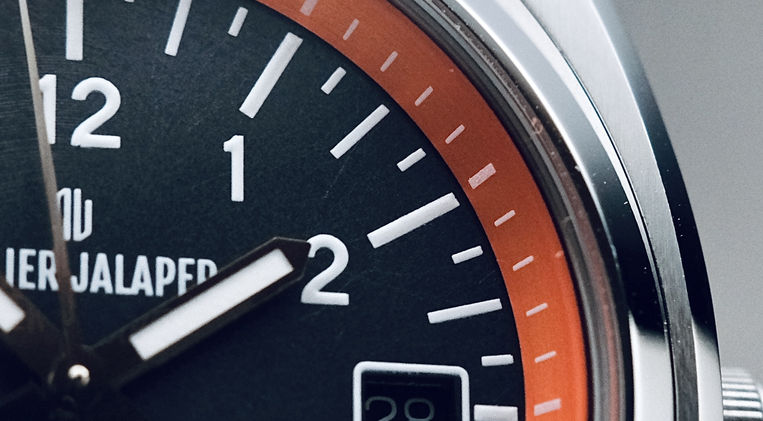Atelier Jalaper AJ-P400 Miura
Like Wearing a Lambo on Your Wrist
Whenever the words “cars” and “watches” come together in my mind, I imagine racing chronographs a la Steve McQueen’s Rolex Daytona. You know, the cool watch for the bad boy of Hollywood which only a movie star could afford to buy. I’m not Steve, I’m not a celebrity, and I don’t care for chronographs but I love—deeply—micro and independent brands which make neat watches at the financial reach of many watch enthusiasts. And, more so I would say, watches that offer something different but not bizarre. Something like a burger made of wagyu beef—which is a meat but with a different taste and a higher concentration of fat–but not something like a patty made of color-filled shreds of recycled fish. Although the latter doesn't make any sense and sounds disgusting, I think you know where I’m going with this. Because what is new doesn’t have to be weird.
Enter Atelier Jalaper out of Belgium and the AJ-P400 Miura. The brand specializes in auto-themed watches where the dials are made of authentic hoods of iconic sports cars. Their first collection the AJ001-B DB5 had a dial made…drumroll…out of a piece of Aston Martin DB5. This model came with a singular design which was a tad abstract, while the one we’re taking a look at today, the AJ-P400 Miura, has a more “traditional” design whilst coming with its own visual DNA. The Miura’s dial, as you might have guessed—should you be into cars which I’m not—is cut out of the hood of a Lamborghini Miura. Do not ask me where Atelier Jalaper gets these hoods from—as I wouldn’t know or couldn’t tell ya?—because what you need to know is that the AJ-P400 has lots to offer in terms of specs and finish in addition to dial material.

Specifications
The most important spec of this watch is the one I’ve already touched upon in the introduction: the fact that the entire dial is made out of the hood of a vintage Lamborghini Miura. Dials are cut out from the hood and made into circular elements, and since they are made out of an old piece of metal, you can easily imagine that each dial looks different. (A bit like dials made out of meteorite all showcase different and unique patterns.) That’s cool, even though I’m not a car person, because upon close inspection of the dial you can see dozens of hairline scratches which testify to the metal’s history and age. Although rocks from outer space do fascinate me, there is a certain romanticism looking at a piece of metal which lived many years and was driven in many places. See? The AJ-P400 might very well convert me into a vintage car person, it’s working!

But this model has lots more to offer besides a cool dial otherwise I wouldn’t have written about it. The AJ-P400 is a wearable and comfortable everyday type of watch which comes with good dimensions: 39.5mm in diameter, 46.58mm lug-to-lug, 10.3mm thick, and a 20mm lug width. “Good” because they are reasonably universal and paired with a great case profile I will touch upon later. And before I forget, this model can be securely fastened onto your wrist by way of a thick, vintage-looking black leather strap complete with quick-release spring-bars and an adjustable deployant-clasp topped with a beautifully machined stainless steel buckle. The outer portions of the straps come with a texture that contributes to the vintage vibe and adds visual interest.

From a pure mechanical standpoint, inside the case of the AJ-P400 Miura we find a Swiss Made Sellita SW270-1 M caliber which has the particularity of being manual wind (that’s what the “M” stands for) and of coming with a power-reserve indicator at the six. The SW270-1 M beats at 28,800 BPH (4Hz) and has about 45 hours of power reserve. I’m going to be honest with you: I don’t care for power reserve indicators but boy do I like it here! Atelier Jalaper had the clever idea of fully integrating it within the dial design by making it look like a gas gauge, so you have the impression of loading up your car (watch) while winding the movement which makes it easier to know when to give it a good wind. (The crown screws-down which is usually seen as being an odd feature of manual-wind calibers.)

Lastly, we find ourselves with a sapphire crystal on the front complete with anti-reflective coating, a see-through case-back made of mineral glass which received a smoked treatment, 50 meters of water resistance, and lume on the hands. (More on that later.) So, as I said, the Atelier Jalaper AJ-P400 has lots to offer in addition to the cool dial. Speaking of which, the latter was anodized after being cut to not only prevent tarnishing but also to give it a slightly darker appearance to facilitate reading the time. Because yes, the Atelier Jalaper AJ-P400 is indeed a watch made to be worn everyday as it is practical and well-made.

Design
What makes this model really interesting to me is the fact that the brand didn’t content itself with finding a cool and rare material to make dials out of and calling it a day. Many brands function this way which is something I don’t understand nor respect. It’s a damn watch and why not make it functional? Exactly, I knew you would understand where I’m coming from. And Atelier Jalaper didn’t simply—once again—add hands and hour markers to make it a watch, instead it drew inspiration from the Lamborghini Miura’s interior design to layout the dial. For example, the hour markers reference those found on the Miura’s speedometer, so is the handset. And the small detail which fascinates me, and which perhaps you haven’t yet caught, is the design of the minute markers which, actually, aren’t minute markers. Instead, they represent interval speeds as found on a speedometer.

Interestingly enough, the way the minute ring was designed doesn’t impact reading the time. Instead, it enhances it by offering us a different way to look at how to divide up an hour. The larger hash-mark between two full hours indicates half-points (30 minutes) while each smaller hash-mark 15 minutes. This is actually reminiscent of single-hand watches that have a similar way of showing blocks of time. (Perhaps the designer who created the first single-hand watch was a huge automobile fan.) Moreover, and as mentioned earlier, the power-reserve indicator was cleverly integrated within the dial, both functionality and visually. And the framed date aperture, located at the three, which sits lower than usual due to the thickness of the dial, is rather discreet. An effect the brand didn’t perhpas intend to achieve but which works well nevertheless.

And the case of the Atelier Jalaper AJ-P400 is in itself a show-stopper. Its profile has something of a cushion-case with ancestry rooted in TV dials of the 1970s/80s. It’s visually massive and imposing although light to wear. Its flanks are tall and long, displaying fine horizontally brushed treatment surrounded by large polished chamfers. Do indeed note the bottom chamfers which climb halfway through the mid-case and aid in making the case visually sit well on the wrist. The upper sections of the case are also brushed, the hooded lugs are massive and visually imposing as well, so is the fully polished oval fixed bezel, the shape of which pays homage to the Lamborghini Miura’s headlights. I don’t know if the crown is supposed to refer to anything else from the car but I find it surprisingly (strangely?) small compared to the case. (Although it’s easy to operate.)

The Heart of the Matter
At the heart of the matter is the fact that Atelier Jalaper created a car-inspired watch which does look like a car but which also exists as a functional and versatile timekeeping device. One which can be worn and used in many situations, for your off-track days doing normal daily things or while competing in a vintage car race. The brand did indeed put a lot of time and effort integrating dials made of an old piece of metal within the traditional codes of watch design which is something worth celebrating. As mentioned in the introduction, I don’t care for watches whose sole merit is to be made of a rare material whilst the rest of it can, and should, usually be thrown in the trash. (I know, I can be mean sometimes and I’m not sorry. This is my magazine after all!) In other words, the AJ-P400 is an actual watch.

The catch, perhaps, is its price tag which is intrinsically connected to the material used for the dial, its treatment, and the unique tooling that was required to make this happen. So, we’re looking at $1,950 USD which is not cheap change—I’m not arguing that—although a sum of money which could have been expected given the high level of customization this model comes with. But I will let you be the final judges of that.

Conclusion
So, the Atelier Jalaper is cool, well-made, and singular in its design. The uniqueness of its dial material is proportionally and adequately matched by a massive and bold case, a good movement, and a neat leather strap. I wouldn’t say here that the AJ-P400 punches over its weight in terms of value-for-money and quality, but it does put in perspective the idea of how much we, watch enthusiasts and collectors, should pay for something different, yet something that is not too bizarre. I bet that another brand could have easily found a way to charge double for what you get here and I would argue that, when looking at the price tag of this model, we should take into consideration the massive amount of work that was necessary to procure the hood of a Lamborghini Miura, make it into dials, and layout the dial and design a case to match it.
I recommend checking out Atelier Jalaper’s website to learn more about the brand and see the full range of the AJ-P400.
Thanks for reading.























